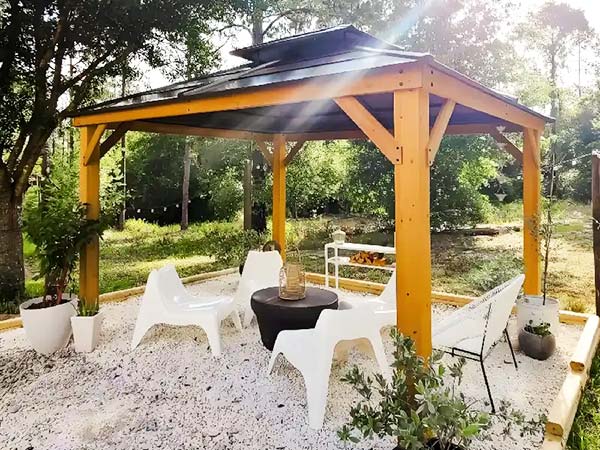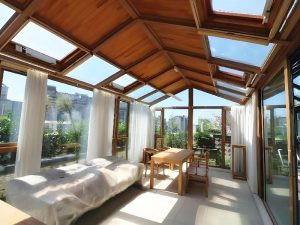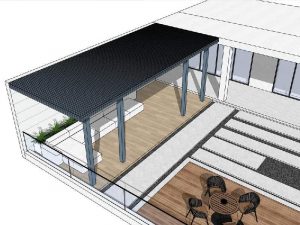In our daily lives, a gazebo or pergola is more than just a place to relax; it adds unique beauty and functionality to our outdoor spaces. However, ensuring the durability of this enjoyment requires proper securing and reinforcement.
Also Read: Best Hardtop Gazebo for Snow and Wind
A stable gazebo or pergola needs meticulous planning and professional installation. The securing methods can vary depending on the foundation type and structure. As a leading manufacturer of gazebos and pergolas, LIDA OUTDOOR will offer essential tips on securing these outdoor structures in this article. Whether installed on grass, bricks, concrete, or wood or if you prefer a no-drill installation, this guide will help you find the best solution.
How to Secure a Gazebo or Pergola on Different Surfaces
Let’s look at various ways to secure your gazebo or pergola based on the type of surface. We’ll explore two main approaches: one involving drilling and another without drilling. This section will cover drilled installations.
Note: Regardless of the surface, level ground is essential. If the surface is uneven, ensure it’s adjusted beforehand for a stable installation.
1. Securing on Pavers
Start by verifying that the pavers are even and firm. Then, determine the hole locations, diameter, and spacing based on the structure’s weight and design. Generally, a hole depth of at least 30 cm provides solid stability.
Fill the holes with concrete and insert anchor bolts to secure the posts to the ground. Use a level to ensure that each post is vertically aligned with the ground.
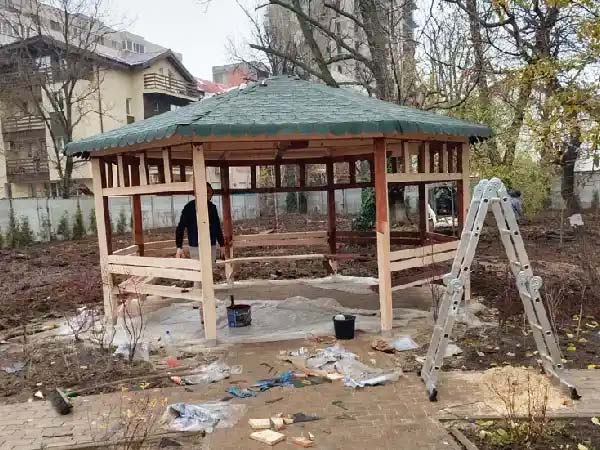
For assembling beams and other parts, galvanized bolts or appropriate connectors are recommended to fasten these securely to the posts. Adding additional screws or fasteners helps ensure a solid connection, making the structure resilient to wind and other external forces.
2. Securing on Concrete, Tile, or Stone Surfaces
For concrete, tile, or stone surfaces, ensure the ground is flat, and pay attention to any slope or unevenness. Use a leveling tool to measure and adjust any height differences.
When working with tiled or stone surfaces, consider a two-step drilling process: use a 5/8-inch drill bit to pierce the tile or stone, followed by a 1/2-inch bit for the concrete layer. This helps prevent cracks in the tile or stone.
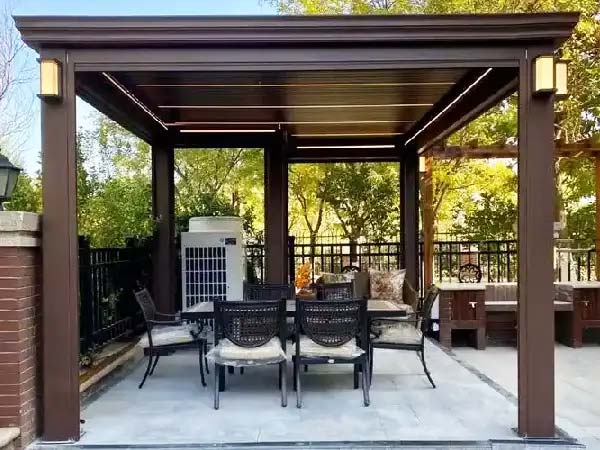
On pure concrete surfaces, expansion screws are effective for direct securing. In areas with high wind, high-wind anchors provide additional protection against lifting forces.
Throughout the installation, ensure all components are tightly connected to avoid wobbling and confirm that the structure is securely anchored to the concrete base.
3. Securing on Rooftops, Patios, or Terraces
For these locations, securing a gazebo or pergola demands robust mounting techniques, especially in high-rise residential areas where insufficient anchoring can lead to serious safety hazards. Here are two reliable methods for secure mounting:
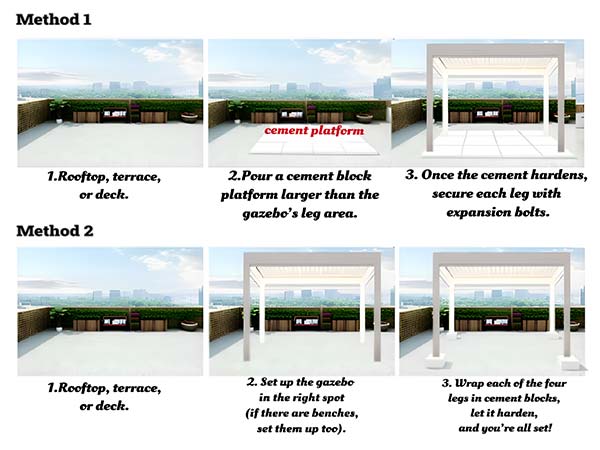
Method 1: Pouring a Concrete Platform
Pour a concrete platform slightly larger than the structure’s footprint. Once it sets, install expansion screws into each post to ensure a stable foundation.
Method 2: Concrete Piers
Set up the structure and then encase each post in concrete. Once the concrete hardens, the gazebo or pergola will be securely anchored. Note: wrap the posts directly in concrete rather than placing them onto pre-made piers, ensuring a snug fit. This is especially crucial if the structure has seating, as it prevents instability.
Safety Note: When installing gazebos or pergolas on high-rise buildings, always ensure compliance with local building codes and regulations.
4. Securing on Grass
For grass installations, you have two options: non-hardened and partially hardened ground.
For a non-permanent option that doesn’t alter the lawn, ground anchors offer a flexible solution. Simply screw the anchors into the ground and secure the posts with ropes. This method maintains lawn integrity but may be less stable.

For added stability, dig a 30×30 cm hole at each post location, pour concrete, and secure the posts with expansion screws once the concrete sets. This method provides solid footing while sacrificing a small section of lawn.
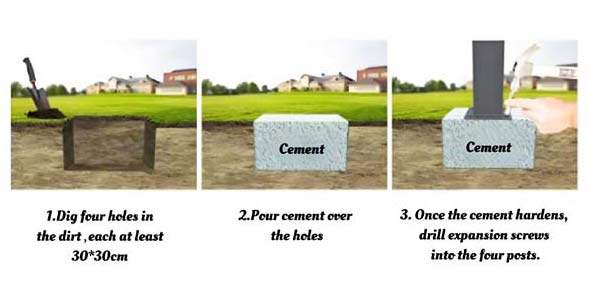
5. Securing on Wooden Decks or Platforms
If your structure is placed on a wooden deck, deck bolts or wooden brackets are ideal. Drill into the deck and use bolts to attach the brackets firmly. Wood may expand or contract due to temperature changes, so leave slight gaps at the joints for natural movement.
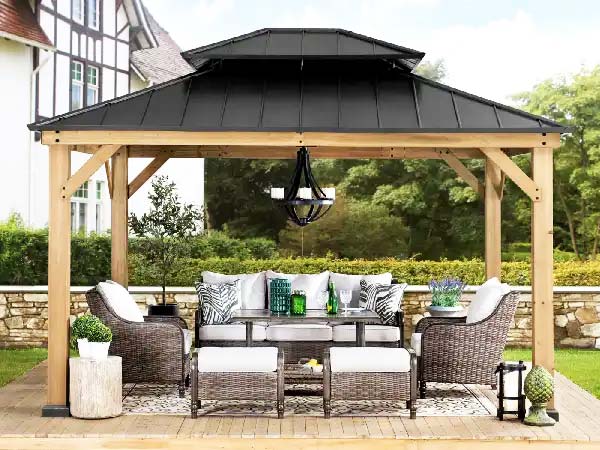
For extra stability, add aluminum or metal plates beneath the deck for a clamping effect. Applying anti-corrosion treatments and paint after installation can extend the lifespan of both the deck and the structure.
How to Secure a Gazebo Without Drilling
While drilling offers superior stability, it’s not always feasible. Here are some effective no-drill options.
1. Heavy-Duty Sandbags or Water Bags
Heavy-duty sandbags or water bags are practical solutions, especially if you want to avoid drilling. Choose bags that suit your structure’s size and weight, such as 800D heavy-duty sandbags or square water bags. Fill sandbags with sand or gravel or water bags with water. Secure them to each corner post with Velcro or rope; ground anchors can provide extra support.
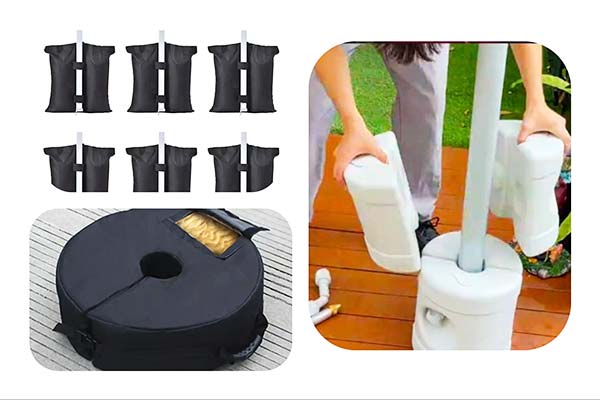
Note: Place the structure on a level surface to avoid tilting. This option is flexible and suitable for short-term use but may lack stability in strong winds.
2. Weighted Outdoor Mats
Heavy-duty outdoor mats can add stability to structures placed on brick or other hard surfaces. Simply arrange mats around the structure to increase its weight and hold it in place under mild wind conditions. This method is ideal for areas with low wind and requires minimal setup, making it perfect for those who need to move the structure often. However, use caution with hard-top structures.
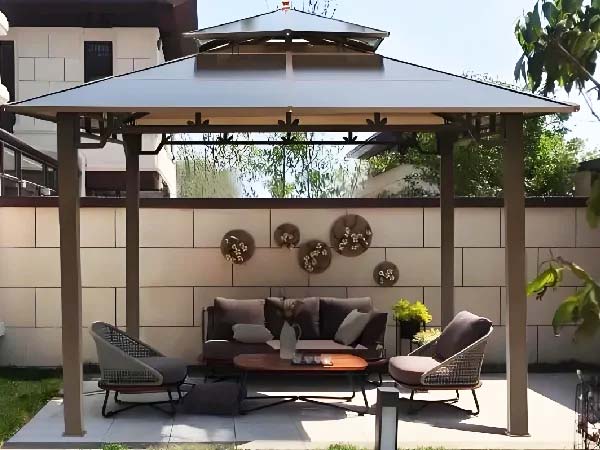
Practical Tips for Reinforcing Your Gazebo or Pergola
To make your gazebo or pergola more resistant to wind, try these reinforcement tips. Adjust the canopy angle slightly downward to reduce wind impact. Also, strong connectors such as bolts, lock fittings, or wind hooks should be added to fortify the entire structure.
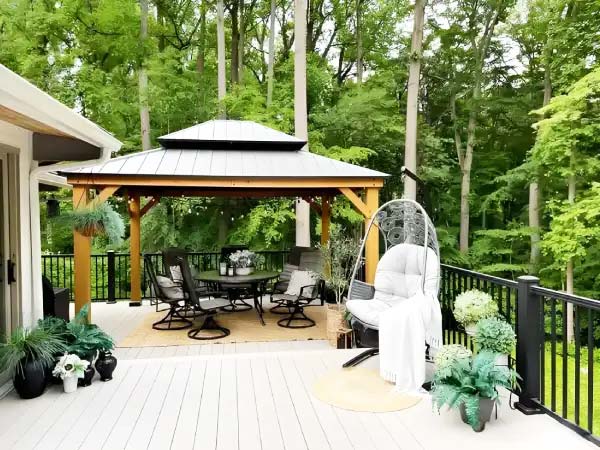
Don’t Miss: How Much Wind Can A Gazebo Withstand?
Periodically inspect support posts and connectors for looseness to maintain long-term stability. Consider sealing the structure after installation to prevent moisture infiltration, extending its lifespan. Using weather-resistant materials or treated wood further enhances durability, helping your gazebo or pergola withstand the elements.
Final Thoughts
If you’re making and installing a gazebo or pergola yourself, mastering these securing methods provides reliable protection. If you are going to buy a patio shade product, you may get detailed instructions and tutorials from the brand. This way, you can easily and quickly set up the gazebo.
If you’re an outdoor furniture distributor or wholesaler, you can consider our LIDA OUTDOOR’’s products. We serve clients globally, offering premium outdoor shade solutions at competitive prices to meet the needs of brands and distributors worldwide.

